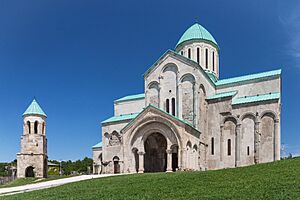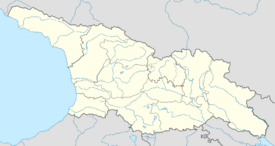Bagrati Cathedral facts for kids
Quick facts for kids Bagrati Cathedralბაგრატის ტაძარი |
|
|---|---|

Bagrati Cathedral in 2014
|
|
| Religion | |
| Affiliation | Georgian Orthodox Church |
| Location | |
| Location | Kutaisi, Imereti, Georgia |
| Architecture | |
| Architectural type | Church |
| Architectural style | Georgian |
| Completed | 11th century |
| Dome(s) | 1, rebuilt |
|
Former UNESCO World Heritage Site
|
|
| Official name: Bagrati Cathedral and Gelati Monastery | |
| Type | Cultural |
| Criteria | iv |
| Designated | 1994 (18th session) |
| Delisted | 2017 |
| Reference no. | 710 |
| UNESCO Region | Europe and North America |
|
Invalid designation
|
|
| Official name: Bagrati Cathedral | |
| November 7, 2006 | |
| 591 | |
| Item Number in Cultural Heritage Portal | 9897 |
| October 3, 2007 | |
The Bagrati Cathedral (which means Bagrat's cathedral) is a very old church in the city of Kutaisi, Georgia. It was built in the 11th century. Its official name is the Cathedral of the Dormition, or the Kutaisi Cathedral.
This cathedral is a great example of medieval Georgian architecture. Over hundreds of years, it was badly damaged. It has been rebuilt and restored many times since the 1950s. Some of the recent work, finished in 2012, caused some debate. Because of these changes, UNESCO first put the cathedral on a list of endangered World Heritage Sites. Later, they removed it from the World Heritage list completely.
Bagrati Cathedral sits on Ukimerioni Hill and is a famous landmark in Kutaisi. Many people consider it one of the four most important cathedrals in the Georgian Orthodox world.
History of Bagrati Cathedral
Bagrati Cathedral was built in the early 1000s. It was named after King Bagrat III, who ruled at that time. A special message on the north wall tells us that the floor was laid in the year 1003.
In 1692, soldiers from the Ottoman Empire attacked the Kingdom of Imereti. During this attack, a cannonball hit the cathedral. This caused the main dome and the ceiling to fall down.
The famous architect William Lethaby once called it "the finest of Georgian monuments."
Restoration work and archaeological studies began in the 1950s. A Georgian architect named Vakhtang Tsintsadze led these efforts. The restoration was done in six main stages and continued for many decades until 1994.
In 1994, Bagrati Cathedral and the nearby Gelati Monastery were added to UNESCO's World Heritage Site list together. In 2001, the Georgian government gave ownership of the cathedral to the Georgian Orthodox Church.
The cathedral is dedicated to the Dormition of the Mother of God. Its main celebration day is called Mariamoba. Today, it is the main church for the Metropolitan of Kutaisi. Regular church services are held there. There is also a monastery on the grounds, and monks serve as the church's clergy. It is a very popular place for weddings among local people. The cathedral is also a main tourist attraction and a symbol of the city of Kutaisi.
Current State and Restoration Issues
In July 2010, UNESCO added Bagrati Cathedral to its list of endangered World Heritage Sites. This was partly because of the ongoing rebuilding work. UNESCO worried that this work might harm the building's original structure and historical value.
Even before the latest reconstruction, in 2008, another group called ICOMOS was concerned about the cathedral's condition. They suggested that any repair work should not change the site's historical importance. In 2011, UNESCO asked the Georgian government to find ways to fix some of the recent changes. However, they noted that these changes might be "almost irreversible."
In 2013, architect Andrea Bruno received a Georgian state gold medal for his work on the cathedral's reconstruction. He was also recognized with an international award for his restoration project.
Despite these awards, UNESCO strongly criticized the restoration work. They said it hurt the cathedral's "integrity and authenticity." Because of these concerns, in 2017, Bagrati Cathedral was removed from the list of World Heritage Sites. However, the Gelati Monastery was removed from the list of sites in danger at the same time.
Burials
See also
- Gelati Monastery
- World Heritage Sites in Georgia
- World Heritage Sites in Danger



